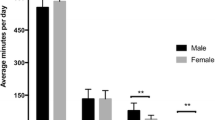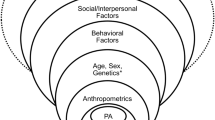Abstract
Purpose This study wants to examine gender’s differences in cardiovascular fitness according to different physical activity categories (high category–moderate category) assessed by IPAQ-A if exists a relationship between cardiovascular fitness and total physical activity, walking, moderate and vigorous physical activity and if cardiovascular fitness in high category and moderate category respects the guidelines for metabolic health in adolescents.
Methods
307 adolescents (15–17 years) were assessed in cardiovascular fitness by Léger test (VO2max) and physical activity level by self-reported questionnaire (IPAQ-A).
Results
Males have showed higher VO2max than females (p < 0.0005). In males, significant differences were found in VO2max in high category compared to moderate category (p < 0.0005), whereas in females, no differences were found. Males have higher VO2max than females in high category (p < 0.0005) and in moderate category (p < 0.0005). No gender’s differences were found in physical activity level. In males and females, small-to-moderate correlations were found between VO2max and total physical activity, moderate, and vigorous physical activity. 75.8% of males and 63.8% of girls have VO2max lower than cutoff for low cardiovascular fitness. In high category, 69% of males and 57.1% of girls and 87.1% of males and 67.7% of females in moderate category do not respect this cutoff.
Conclusion
Adolescents present low cardiovascular fitness levels, exposing themselves to the cardiovascular disease’s risk. Small-to-moderate correlations were found between physical activity and cardiovascular fitness. It is necessary to adopt strategies to improve physical activity in young people. IPAQ-A presents some limits to identify PAL in young people.

Similar content being viewed by others
References
US Department of Health and Human Services (2010) Healthy people 2020, 2nd edn. USDHH, Washington
Poitras VJ, Gray CL, Borghese MM et al (2016) Systematic review of the relationships between objectively measured physical activity and health indicators in school-aged children and youth. Appl Physiol Nutr Metab 41:S197–S239
WHO (2011) Global Recommendations on Physical Activity for Health. WHO http://www.who.int/dietphysicalactivity/pa/en/index.html
Sallis JF, Bull F, Guthold R et al (2016) Progress in physical activity over the Olympic quadrennium. The Lancet. doi:10.1016/S0140-6736(16)30581-5
Ortega FB, Ruiz JR, Castillo MJ, Sjostrom M (2008) Physical fitness in childhood and adolescence: A powerful marker of health. Int J Obes 32:1–11
Castro-Piñero J, Padilla-Moledo C, Ortega FB et al (2012) Cardiorespiratory fitness and fatness are associated with health complaints and health risk behaviors in youth. J Phys Activ Health 9:642–649
Ruiz JR, Huybrechts I, Cuenca-García M et al (2015) Cardiorespiratory fitness and ideal cardiovascular health in European adolescents. Heart 101:766–773
Silva DA, Tremblay M, Pelegrini A et al (2016) Association between aerobic fitness and high blood pressure in adolescents in brazil: evidence for criterion-referenced cut-points. Pediatr Exerc Sci 28:312–320
Hogstrom G, Nordstrom A, Nordstrom P (2014) High aerobic fitness in late adolescence is associated with a reduced risk of myocardial infarction later in life: a nationwide cohort study in men. Euro Heart J 35:3133–3140
Dyrstad SM, Berg T, Tielta LI (2012) Secular trends in aerobic fitness performance in a cohort of Norwegian adolescents. Scan J Med Sci Sports 22:822–827
Piccinno A, Colella D (2014) Physical fitness level in Italian high-school adolescents: a cross-sectional study. J Phys Educ Sport 14:431–437
Pescatello LS, Arena R, Riebe D, Thompson PD (2014) ACSM’s guidelines for exercise testing and prescription, 9th edn. Wolters Kluwer/Lippincott Williams & Wilkins, Philadelphia
Léger LA, Mercier D, Gadoury C, Lambert J (1988) The multistage 20 m shuttle run test for aerobic fitness. J Sports Sci 6:93–101
Mayorga-Vega D, Aguilar-Soto P, Viciana J (2015) Criterion-related validity of the 20-m Shuttle run test for estimating cardiorespiratory fitness: a meta-analysis. J Sport Sci Med 14:536–547
Adegboye ARA, Anderssen SA, Froberg K et al (2011) Recommended aerobic fitness level for metabolic health in children and adolescents: a study of diagnostic accuracy. Br J Sports Med 45:722–728
Mynarski W, Rozpara M, Czapla K, Garbaciak W (2009) Aerobic capacity of students with different levels of physical activity as assessed by IPAQ. J Hum Kinet 21:89–96
Serrano-Sánchez JA, Delgado-Guerra S, Olmedillas H et al (2010) Adiposity and age explain most of the association between physical activity and fitness in physical activity men. PLoS One 5:e13435
Dyrstad SM, Anderssen SA, Edvardsen E, Hansen BH (2016) Cardiorespiratory fitness in groups with different physical activity levels. Scand J Med Sci Sports 26:291–298
Shook RP, Gribben NC, Hand GA et al (2016) Subjective Estimation of physical activity using International Physical Activity Questionnaire varies by fitness level. J Phys Activ Health 13:79–86
Jaakkola T, Yli-Piipari S, Huotari P, Watt A, Liukkonen J (2016) Fundamentals movement skills and physical fitness as predictors of physical activity: a 6-year follow-up study. Scand J Med Sci Sports 26:74–81
Hagströmer M, Bergman P, De Bourdeaudhuij I et al (2008) Concurrent validity of a modified version of the International Physical Activity Questionnaire (IPAQ-A) in European adolescents: The HELENA Study. Int J Obes 32:S42–S48
Ottevaere C, Huybrechts I, De Bourdeaudhuij I et al (2011) Comparison of the IPAQ-A and Actigraph in relation to VO2max among European adolescents: The HELENA study. J Sci Med Sport 14:317–324
Taber DR, Pratt C, Charneco EY et al (2014) Participation in vigorous sports, not moderate sports, is positively associated with cardiorespiratory fitness among adolescent girls. J Phys Activ Health 11:596–603
Kristensen PL, Moeller NC, Korsholm L et al (2010) The association between aerobic fitness and physical activity in children and adolescents: the European youth heart study. Eur J Appl Physiol 110:267–275
Armstrong N, Welsman JR, Kirby BJ (2000) Longitudinal changes in 11-13-year-olds’ physical activity. Acta Paediatr 89:775–780
Ainsworth BE, Haskell WL, Whitt MC et al (2000) Compendium of physical activities: an update of activity codes and MET intensities. Med Sci Sports Exerc 32:S498–S504
Hopkins WG, Marshall SW, Batterham AM, Hanin J (2009) Progressive statistics for studies in sports medicine and exercise science. Med Sci Sports Exerc 41:3–13
Sandercock G, Voss C, Cohen D, Taylor M, Stasinopoulos DM (2012) Centile curves and normative values for the twenty metre shuttle-run test in English schoolchildren. J Sports Sci 30:679–687
Welk GJ, Saint-Maurice PF, Csányi T (2015) Health-related physical fitness in Hungarian youth: Age, sex and regional profiles. Res Q Exerc Sport 86:S45–S57
Tomkinson GR, Olds TS (2007) Secular changes in pediatric aerobic fitness test performance: the global picture. Med Sport Sci 50:46–66
Tomkinson GR, Lang JJ, Tremblay MS et al (2016) International normative 20 m shuttle run values form 1.142.026 children and youth representing 50 countries. Br J Sports Med doi:10.1136/bjsports-2016-095987
Armstrong N, Mcnarry M (2016) Aerobic fitness and trainability in healthy youth: gaps in our knowledge. Pediatr Exerc Sci 28:171–177
Bergier B, Bergier J, Paprzycki P (2014) Level and determinants of physical activity among school adolescents in Poland. Ann Agric Environ Med 21:75–78
Al-Hazzaa HM, Al-Nakeeb Y, Duncan MJ et al (2013) A Cross-cultural comparison of health behaviors between saudi and british adolescents living in urban areas: gender by country analyses. Int J Environ Res Public Health 10:6701–6720
Paudel S, Subedi N, Mehata S (2016) Physical activity level and associated factors among higher secondary school students in Banke, Nepal: a cross-sectional study. J Phys Activ Health 13:168–176
Yli-Piipari S, Leskinen E, Jaakkola T, Liukkonen J (2012) Predictive role of physical education motivation: the developmental trajectories of physical activity during grades 7–9. Res Q Exerc Sport 83:560–578
Mayorga-Vega D, Viciana J (2015) Differences in physical activity levels in school-based contexts: influence of gender, age and body weight status. Kinesiology 47:151–158
Gulati M, Pandey DK, Arnsdorf MF et al (2003) Exercise capacity and the risk of death in women: the St James Women Take Heart Project. Circulation 108:1554–1559
Myers J, Prakash M, Froelicher V, Do D, Partington S, Atwood JE (2002) Exercise capacity and mortality among men referred for exercise testing. N Engl J Med 346:793–801
Steene-Johannessen J, Anderssen SA, Van der Ploeg HP et al (2016) Are self-report measures abel to define individuals as physically active or inactive? Med Sci Sports Exerc 48:235–244
Tomaz SA, Lambert EV, Karpul D, Kolbe-Alexander TL (2016) Cardiovascular fitness is associated with bias between self-reported and objectively measured physical activity. Eur J Sport Sci 16:149–157
Canning KL, Brown RE, Jamnik VK, Salmon A, Ardern CI, Kuk JL (2014) Individuals understimate moderate and vigorous intensity physical activity. PLoS ONE 9:e97927
Bouchard C, An P, Rice T, Skinner JS et al (1999) Familial aggregation of VO2max response to exercise training: results from the HERITAGE Family Study. J Appl Physiol 87:1003–1008
Ekelund U, Steene-Johannessen J, Brown WJ et al (2016) Does physical activity attenuate, or even eliminate, the detrimental association of sitting time with mortality? A harmonised meta-analysis of data from more than 1 million men and women. Lancet. doi:10.1016/S0140-6736(16)30370-1
Kim IY, Park S, Trombold JR, Coyle EF (2014) Effects of moderate-and intermittent low-intensity exercise on postprandial lipemia. Med Sci Sport Exerc 46:1882–1890
van Dijk JW, Venema M, van Mechelen W et al (2013) Effect of moderate-intensity exercise versus activities of daily living on 24-hour blood glucose homeostasis in male patients with type 2 diabetes. Diabetes Care 36:3448–3453
Carlin A, Murphy MH, Gallagher AM (2016) Do interventions to increase walking work? A systematic review of interventions in children and adolescents. Sports Med 46:515–530
Acknowledgements
There was no conflict of interest to declare.
Author information
Authors and Affiliations
Corresponding author
Ethics declarations
Conflict of interest
The authors declare that they have no conflict of interest.
Ethical approval
All procedures performed in studies involving human participants were in accordance with the ethical standards of the institutional and/or national research committee and with the 1964 Helsinki declaration and its later amendments or comparable ethical standards.
Informed consent
Informed consent was obtained from all individual participants included in the study.
Rights and permissions
About this article
Cite this article
Piccinno, A., Colella, D. Differences in cardiovascular fitness of Italian high-school adolescents according to different physical activity levels assessed by IPAQ-A: a cross-sectional study. Sport Sci Health 13, 149–155 (2017). https://doi.org/10.1007/s11332-016-0326-5
Received:
Accepted:
Published:
Issue Date:
DOI: https://doi.org/10.1007/s11332-016-0326-5




